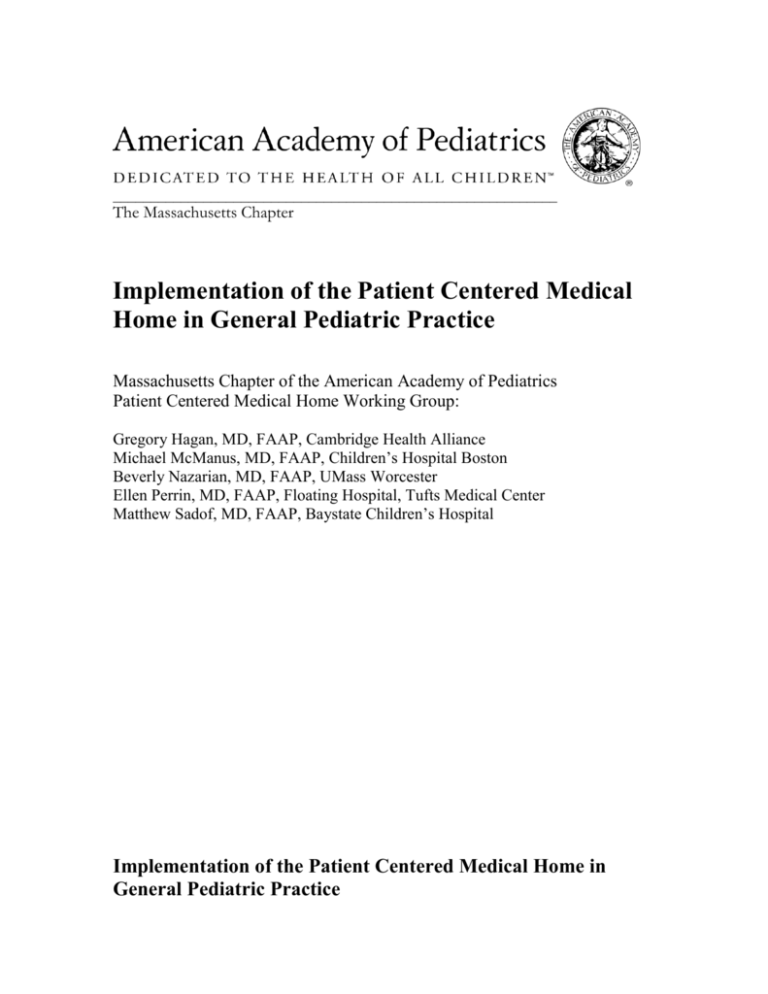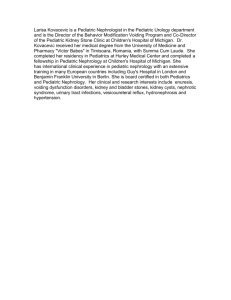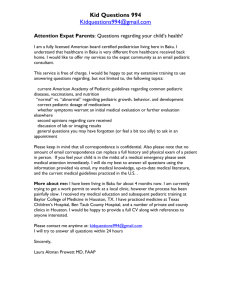MCAAP Medical Home White Paper - The Massachusetts Chapter of
advertisement

___________________________________________________________ The Massachusetts Chapter Implementation of the Patient Centered Medical Home in General Pediatric Practice Massachusetts Chapter of the American Academy of Pediatrics Patient Centered Medical Home Working Group: Gregory Hagan, MD, FAAP, Cambridge Health Alliance Michael McManus, MD, FAAP, Children’s Hospital Boston Beverly Nazarian, MD, FAAP, UMass Worcester Ellen Perrin, MD, FAAP, Floating Hospital, Tufts Medical Center Matthew Sadof, MD, FAAP, Baystate Children’s Hospital Implementation of the Patient Centered Medical Home in General Pediatric Practice While the concept of the Medical Home was for many years an exclusively pediatric construct, this model has been adopted in recent years by the primary care disciplines that care for adults as well. The bulk of pediatric experience and research regarding the Medical Home has historically been focused on the care of medically complex children and youth with special health care needs (CYSHCN). The challenge before us now, as the Patient Centered Medical Home (PCMH) concept is rolled out across the Commonwealth, is to expand our construct to encompass the full range of services provided by pediatricians for all children and their families. Pediatricians share with the other primary care disciplines a commitment to the “Joint Principles of the Patient-Centered Medical Home” 1 This policy statement outlines the common, underlying principles that apply to the care of adults, children and families: Personal physician Physician directed medical practice Whole person orientation Care is coordinated and/or integrated Quality and safety Enhanced access Appropriate payment However, the Pediatric Medical Home will necessarily look somewhat different from the Medical Home envisioned for adult patients. The needs of children and their families are distinctive and implementation of the Medical Home model in daily pediatric practice must take these differences into account. So, within the framework of the established goals and priorities of the Medical Home, what are the necessary elements for general pediatric practice? I. “Children Have Different Preventive Health Care Needs. Pediatric preventive health care is fundamentally different from adult preventive health.” 2 “Bright Futures” forms the basis for determining the essential services for children and families. “The benefit of Bright Futures is that it begins family-centered lifelong health promotion activities that emphasize healthy nutrition, exercise, positive mental health, injury prevention, healthy sexual development, violence prevention, and the avoidance of tobacco, drugs, and alcohol. All of these sow the seeds for healthy adult life styles. These preventive services will have enormous benefits not only for children while they are young, but doing the right thing for children will help prevent the adult consequences of obesity, mental illness and developmental dysfunction.” 3 This is the care we give. This is the core of what we do. While pediatrics also involves “Disease Management”, the Pediatric Medical Home must, first and foremost, support the crucial activities of preventive care and anticipatory guidance. The model must facilitate the coordination of complex medical, social, family support and developmental needs which transcend the usual medical “organ system” or “disease management” model. Our challenges include problems such as obesity (treatment & prevention), asthma, ADHD and other developmental and behavioral health issues, but also the full range of preventive services that currently form the core of pediatric practice. II. Pediatric Medical Home: Essentials Providing quality care for children and their families in a pediatrics-friendly medical home requires that the core elements of current pediatric practice are maintained and strengthened. But pediatricians know that we must look beyond the purely “medical” issues confronting our families if we are to truly meet their needs. Most pediatric practices currently attempt to provide many aspects of the care that should constitute a medical home, we but face many impediments. Much of this care is costly, and there is little or no reimbursement to the practice. Examples of this uncompensated care include: Coordination with medical and surgical specialists Coordination with community agencies Coordination with schools Coordination with community-based developmental/mental health assessment and treatment services Coordination with other community resources Phone calls/emails with families Managing health insurance/financing issues Writing letters/ completing forms There are inadequate supports available to provide these services in a comprehensive, coordinated way. Resources are scattered and fragmented. There is inadequate time for the physician to attend to these “non-medical”, but essential, aspects of patient care. And many of the skills needed for these tasks lie outside of the scope of our training. The task before us is to create a model that allows us to provide the best care in a comprehensive, coordinated fashion, leading to better outcomes and more rational use of scarce health care resources. The strong partnerships that already exist among pediatricians, children and families must play the central role in defining how these services should be configured, delivered, measured and financed. The medical home must help families to identify and access crucial community resources and must coordinate with these resources. Our model will need to be very flexible in order to fit the many, varied practice arrangements and communities served: private practices large and small; clinics and neighborhood health centers; hospital based primary care clinics and pediatric practices within larger multi-specialty groups. The Medical Home will consist of a physician-led team and a variety of other professionals. In addition to the pediatrician, team members could include some or all of the following: trained care coordinators, nurses, nurse practitioners and other advanced practice clinicians, nutritionists, social workers, other mental health professionals, developmental specialists, family advisory groups and community liaisons. The model must provide and support specific mechanisms that will facilitate integration and collaboration among these providers of care. The structure and composition of the team will also need to be flexible, given variations in practice philosophies, size and structure. Preferably, members of a team within the practice will perform most of these functions. Smaller practices, especially in more rural settings, may prefer to develop shared resources. In addition, in a pediatric Medical Home the care must be family-centered, not just patient-centered. Family-centered care involves a partnership with families that respects their expertise and values their input. The entire practice needs to be family-centered at all points of contact (phones, front desk, etc.). Practices should solicit input from families, whether by surveys, parent advisory boards, or other means, not only about the care of their children, but also how the practice itself can best meet their needs. III. The Care The physician will provide the medical care in the Pediatric Medical Home, with the support of nursing. Other members of the team will more appropriately perform other essential, diverse services based on their expertise and training. The essential services must encompass, at a minimum, the following: Tracking and coordination of routine “Well Child Care” for all children o Scheduling timely, routine visits according to recommended schedules (“Bright Futures” and EPSDT) o Tracking and out-reach to children/families who are behind on routine preventive care, including immunizations. o Screening, surveillance and implementation of other core elements of “Bright Futures” and EPSDT screening Coordinated, comprehensive care of chronic conditions to ensure consistent follow-up and quality, including o Coordination with pediatric surgical and sub-specialty services. o Coordination with the many non-medical, community-based supports (Schools, Head Start, WIC, Vendors for Durable Medical Goods, VNA, etc.) especially for medically complex children and youth with special health care needs The following examples illustrate some of the concerns that will need this kind of coordinated, comprehensive care. This is not an exhaustive list of chronic pediatric medical problems. The PCMH will need to be flexible enough to adopt these models to the many other issues that require coordinated care.) o Obesity Identify overweight and obese children and adolescents Track and facilitate regular follow-up Engage families in the process of adopting healthier lifestyles. (For example, encouraging physical activity in safe environments, limitations on screen time and media exposure, an limitations of sugary beverages) Coordinate with Nutrition, sub-specialists, schools and other community resources o ADHD Coordination of diagnostic materials Referral to community resources for psychosocial aspects of management Coordination with schools, therapists and social service agencies Track medication use Track follow-up visits to monitor behavioral and academic progress, growth and BP o Asthma Ongoing asthma education for children and for parents Monitor and foster good adherence to “controller” therapy Monitor ED visits and hospital in-patient admissions Coordination of care with schools, pre-schools, etc. Systematic tracking and outreach for annual influenza vaccination Home visits o Coordination of developmental and behavioral health services Routine Screening / surveillance Referrals and coordination with Early Intervention Referrals and coordination with schools and Special Education services Referrals and coordination with therapists and social Workers Referrals and coordination with specialists in Developmental Pediatrics, Neurology, Neuropsychology and Psychiatry The importance of “getting it right” with regard to developmental and behavioral issues warrants further emphasis: There is strong evidence that: Developmental and mental health problems of children and family members are among the most debilitating issues faced by families and children. The recognized prevalence of these problems appears to be increasing, among all socioeconomic groups. Mental health problems of children and family members have a serious negative effect on parents’ and children’s physical health. Mental health problems of both children and family members can have a serious negative effect on the long-term health of the individuals and the larger community. Children with chronic physical health conditions commonly experience serious secondary mental health and developmental morbidity Pediatricians have unique access to (especially preschool) children and their parents. They should therefore have a central role in coordinating efforts aimed at prevention, recognition, and intervention. Local networks of care developed in partnership with therapists, social work and other agencies, schools and the families themselves envisioned in the Medical Home model have tremendous potential for preventing and treating developmental and behavioral problems before they become chronic and intractable. Mental Health “carve-outs” are incompatible with the concept of the Pediatric Medical Home. IV. Financing the Medical Home As Dr. Judy Palfrey, President of the American Academy of Pediatrics (AAP) has testified before Congress, “…There is good evidence that appropriate payment of providers will result in children having better access to comprehensive health services in a medical home. We are hopeful that as the health reform process evolves, you continue to prioritize coverage, benefits and access to medical homes through appropriate payment rates for child health services.” 3 Of particular concern to physicians who care for children is the long-standing undervaluing of pediatric medicine. “Currently, the average state Medicaid program pays providers at a rate that is 72% of Medicare rates.”4 Pediatric nurses and staff do not work for 28% less than the nurses and staff in Internal Medicine and Family Medicine practices. Pediatrics practices do not enjoy discounted leases, medical supplies or practice management services. If quality care is to be delivered to children and families, this chronic inequity must be remedied, bringing Medicaid payment up to parity with Medicare rates. In general, appropriate reimbursement should include: Recognition of relevant payment codes and payment for cognitive services Recognition of expanded care coordination responsibilities Recognition of new quality improvement activities Inclusion of the costs associated with the necessary new, up-front investments (EMRs and registries) Recognition of the time and resources necessary for initial learning collaboratives and medical home planning. The American Academy of Pediatrics recommends the following: “All private and public payers should adopt a comprehensive set of medical home payment reforms that include three components: 1. A contact or visit-based fee component that recognizes and values evaluative/cognitive services and also preventive counseling based upon Bright Futures. 2. A care coordination fee to cover physician and non-physician clinical and administrative staff work (telephone care, on-line communication, conferences with the “care team”) linked to the delivery of medical home services. 3. A performance or pay-for-performance fee for evidence-based process, structure, or outcome measures and paid as a bonus. This bonus should take into consideration the complexity of the patients who are in the panel of the practice. In return for this bonus, physicians should assist payers in addressing such cost centers as emergency department utilization and unnecessary hospitalization. Vaccines and their administration costs must be adequately paid for to exceed total direct and indirect expenses and updated when new vaccines are adopted into recommended schedules or when vaccine prices increase. Payments should be closely tied to evidence-informed medicine, and methods used for payment should consider the child’s age, chronicity, and severity of underlying problems, and geographic adjustment. Payment policies should recognize and reward systems of care that promote continuous and coordinated care “24/7”, including care coordinated between generalists and specialists, population-based prevention, and should discourage the use of clinics that provide episodic care only for minor conditions. Competition should be structured so that practices are rewarded for providing access, service, and quality; cheaper care is probably not better care. The Centers for Medicare and Medicaid Services should update the Resource-Based Relative Value Scale to take into account the value of the complex and comprehensive nature of cognitive care and practice expenses associated with the medical home model of care, provide health information technology support, and create incentives for continuous quality improvement. Congress should sponsor ongoing, large-scale Medicaid medical home pilot projects for children and youth. It should also support an all-payer pilot project of the medical home model for children and youth. Congress should evaluate current state Medicaid and CHIP programs and share information among the states about state programs that are providing good medical homes for children.” 5 In the event that a global payment mechanism is adopted, the payment needs to be adequate to incorporate all of the services outlined above. Some practices such as Group Health in Seattle, have found that they are able to improve access, outcomes, and patient satisfaction by reducing panel sizes. However, introduction of a capitated, per member per month payment system (Accountable Care Organizations or ACOs) in conjunction with reduced panel sizes could have the unintended consequence of inadequate funding for medical home activities. We must ensure that payment adequately reflects the value of the medical home services. “Performance measurement for determining the amount of shared savings or other financial incentives for ACOs must weight primary care measures heavily rather than focus narrowly on metrics related to hospital care.”6 V. Quality Measures Assuring the highest quality pediatric care is a central goal of the Pediatric Medical Home. A variety of quality measures have been proposed, and on-going quality assurance will ensure that our patients and families receive the best, evidence-based, comprehensive care available. The National Committee for Quality Assurance has developed a set of measures that are becoming widely used. (http://www.ncqa.org/) At the same time, it is critical to bear in mind that the bulk of pediatric primary care in the Commonwealth is provided by private practitioners in the context of private practice. These practices are small businesses, already burdened by high costs and rising overhead. In choosing quality measures, it will be paramount to keep the processes involved from being overly bureaucratic, time-consuming and costly. VI. Managing Change A successful transition to the PCMH will mean significant change and reorientation in most pediatric practice settings: private practices, clinic and academic medical practices. But the goal - high quality pediatric care - is not new. The PCMH concept applied broadly and implemented wisely will provide the necessary resources and supports to do what we have always done, but more rationally, more consistently and with better outcomes. Implementation of the measures outlined above will be challenging and stressful to the system, as well as to the individual practitioners. The daily work routine will be altered to some extent and pediatricians, as a group, will need to become more comfortable with delegating, coordinating and adopting the role of “Team Leader”. Pediatricians currently spend an enormous amount of time on tasks that would be more efficiently performed by others. We know there are ways in which patient care could be improved, but we often lack the time, training and expertise to manage the “non-medical” aspects of care. The PCMH provides an unprecedented opportunity to correct these shortcomings, both by supporting training and collegial collaboration and by encouraging the development of functional practice teams. The medical care and over-all patient/family care should be managed and directed by the pediatrician. But care coordinators should coordinate care. Nursing tasks should be performed by nurses. Social service issues should be managed by social workers. Developmental and behavioral health concerns should be addressed by professionals trained in those areas. In some respects, this change is simply the restoration of a rational division of labor to the complex care that we oversee, with the resources needed to make it work. Change is seldom easy. While the changes may ultimately prove beneficial, we must proceed deliberately and cautiously. The health of children, families and pediatric medicine are all at stake. Notes: 1.) Joint Principles of the Patient-Centered Medical Home March 2007 American Academy of Family Physicians (AAFP) American Academy of Pediatrics (AAP) American College of Physicians (ACP) American Osteopathic Association (AOA) 2.) Hagan, J F Jr, MD, FAAP Testimony on behalf of the American Academy of Pediatrics before the US Senate Committee on Health, Education, Labor and Pensions January 27, 2009 3.) Palfrey, Judith, MD, FAAP President, American Academy of Pediatrics Testimony before the US Senate Committee on Health, Education, Labor and Pensions June 11, 2009 4.) Palfrey, Judith, MD, FAAP President, American Academy of Pediatrics How Health Care Reform Can Benefit Children and Adolescents, New England Journal of Medicine, 10.1056/NEJMp0908051, October 7, 2009 5.) Raulerson, M, MD, FAAP Testimony on behalf of the American Academy of Pediatrics before the US Senate Committee on Health, Education, Labor and Pensions May 14, 2009 6.) Diane R. Rittenhouse, M.D., M.P.H., Stephen M. Shortell, Ph.D., M.P.H., M.B.A., and Elliott S. Fisher, M.D., M.P.H. Primary Care and Accountable Care — Two Essential Elements of Delivery-System Reform New England Journal of Medicine, 361: 2301-2303, December 10, 2009





